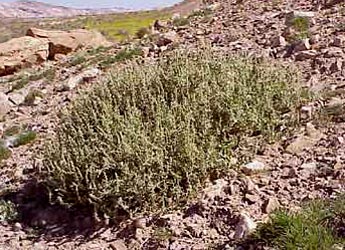Gardner Saltbush

Common Name(s):
Gardner Saltbush
Gardner's Saltbush
Scientific Name:
Atriplex gardneri (Moq.) D. Dietr.
Scientific Name Synonyms:
None known
another synonym goes here
Symbol:
ATGA
Description:
Life Span: Perennial
Origin: Native
Season: Evergreen
Growth Characteristics: Gardner saltbush is a spreading, low-growing subshrub. It can be decumbent in growth or rounded, and grows 8 to 20 inches tall. It is much-branched, with branches producing adventitious roots where they contact the soil. It flowers June to August. Reproduces from seeds and rootstalks.
Flowers/Inflorescence: Flowers are unisexual and found in dense clusters towards the branch tips giving the appearance of a terminal inflorescence. Male flowers are brown, and the female flowers are borne on leafy spikes. The herbaceous flowering stems rise above the woody, decumbent portion of the plant.
Fruits/Seeds: Fruit is a utricle and ripens about 7 weeks after flowering. Seeds brown.
Leaves: Alternate, sometimes opposite below or occurring in fascicles. Leaf blades are narrowly linear, and thick. The tip is rounded, and the base is narrowed. Margins are entire. Surfaces are gray-green.
Stems: Twigs are slender, erect or ascending, often herbaceous. Twigs start with white hairs, later turning smooth and dark. Trunk bark is light gray, smooth, and somewhat shreddy.
Ecological Adaptions:
Gardner saltbush is found on plains, badlands, and in valleys, usually occupying sites that are harsh and arid with widely fluctuating temperatures and high winds.
Soils: Gardner saltbush is most common on saline, poorly developed, or clay soils with a pH of 7.8 to 8.6. Soils are typically low in available phosphorous, nitrogen, and potassium. Gardner saltbush also grows on sodic, silty, or sandy soils
Associated Species: Fourwing saltbush, shadscale.
Uses and Management:
Gardner saltbush provides nutritious forage for livestock and wildlife species throughout its range. Antelope, mule deer, rabbits, and mourning doves browse Gardner saltbush. Its persistent leaves are an important winter food source. It is particularly important for sheep because it provides the minimum nutritional requirement for maintenance of gestating ewes.
Although overgrazing may reduce plant vigor, winter grazing of up to 35 percent of total plant biomass allows for maintenance of Gardner saltbush populations. Halogeton, a species poisonous to livestock, is unable to invade moderately grazed Gardner saltbush sites.
American Indians ground parched fruits to make pinole flour.

